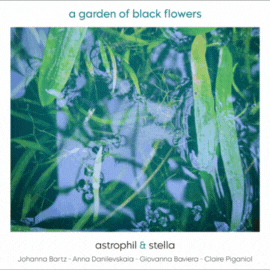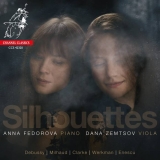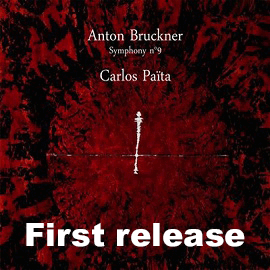 Silhouettes; Rebecca Clarke: Sonate für Viola & Klavier; Claude Debussy: La Plus que Lente + Clair de Lune + Beau Soir (Transkr. Für Viola und Klavier); Arne Werkman: Suite für Viola & Klavier op. 51; Darius Milhaud: Sonate für Viola & Klavier Nr. 1; George Enescu: Konzertstück für Viola & Klavier; Dana Zemtsov (Viola), Anna Fedorova (Klavier); 1 CD Channel Classics; Aufnahme 2019, Veröffentlichung 24/06/2020 (71'45) - Rezension von Remy Franck
Silhouettes; Rebecca Clarke: Sonate für Viola & Klavier; Claude Debussy: La Plus que Lente + Clair de Lune + Beau Soir (Transkr. Für Viola und Klavier); Arne Werkman: Suite für Viola & Klavier op. 51; Darius Milhaud: Sonate für Viola & Klavier Nr. 1; George Enescu: Konzertstück für Viola & Klavier; Dana Zemtsov (Viola), Anna Fedorova (Klavier); 1 CD Channel Classics; Aufnahme 2019, Veröffentlichung 24/06/2020 (71'45) - Rezension von Remy Franck
Dana Zemtsovs und Anna Fedorovas neues Album beginnt mit Rebecca Clarkes hinreißender Sonate für Viola und Klavier. Rebecca Clarke kam 1886 in Harrow, England, zur Welt. Sie studierte an der Royal Academy of Music in London Komposition und Viola. Sie wurde eine gefragte Kammermusikerin und Orchestermusikerin. Als Komponistin hatte sie es schwer, sich durchzusetzen. Von ihren fast 100 Kompositionen wurden zu ihren Lebzeiten nur etwa 20 veröffentlicht.
In einem Interview aus dem Jahre 1976 erzählt Clarke, wie sie im Jahr 1919 in einem Kompositionswettbewerb in den USA mit ihrer Bratschensonate den zweiten Preis gewann, worauf das Gerücht entstand, dass sie das Stück nicht selbst geschrieben hätte, sondern dass jemand anderes es für sie getan hätte. Ein Berichterstatter behauptete, dass Rebecca Clarke gar nicht existieren würde, dass der Name vielmehr ein Pseudonym sei: « And when I had that one little whiff of success that I’ve had in my life, with the Viola Sonata, the rumour went around, I hear, that I hadn’t written the stuff myself, that somebody had done it for me. And I even got one or two little bits of press clippings saying that it was impossible, that I couldn’t have written it myself. And the funniest of all was that I had a clipping once which said that I didn’t exist, there wasn’t any such person as Rebecca Clarke, that it was a pseudonym for Ernest Bloch! (…) I take this opportunity to emphasize that I do indeed exist … and that my Viola Sonata is my own unaided work! »
Die Sonate beginnt mit einem intensiv lyrischen Impetuoso, das die beiden Solistinnen dieser Aufnahme sehr farbig und spannungsvoll spielen, so dass man unmittelbar von diesem eindrucksvollen Musizieren gefangen genommen wird. Der Mittelsatz, Vivace, ist ein lebhaftes Scherzo, das genauso packend gespielt wird wie das schwärmerische Finale. Dana Zemtsov lässt die wunderbaren Melodien in einem farbigem Spiel fließen, brillant und mit raffinierter Phrasierung am Klavier unterstützt von Anna Fedorova.
Die Suite von Arne Werkman enthält vier Tanzarten, die sich mit moderner Sicht auf die Barockzeit reizvoll entwickeln und in schillernden Farben des perfekt aufeinander abgestimmten Duos eine hohe Qualität erlangen.
Virtuos gehen die beiden Interpretinnen die 1944 entstandene Viola-Sonate von Darius Milhaud an, in deren Air die Bratschistin wiederum mit einem sehr feinen, lyrischen Spiel für sich einnimmt.
Wunderbar stimmungsvolle Aufführungen von gut gemachten Arrangements kleiner Debussy-Stücke sowie des Konzertstücks von Enescu lassen dieses Programm zu einem echten Musikereignis werden. Enescus Werk ist in seiner Qualität alles andere als ein bloß technisch ausgerichtetes Examensstück, als das Fauré es 1906 bestellt hatte. Das spätromantische Stück wird vom Duo Zemtsov und Fedorova mit beachtlicher Noblesse, aber auch Leidenschaftlichkeit gespielt. Das Aufeinanderhören und Miteinanderfühlen des Duos ist phänomenal.
Dana Zemtsov’s and Anna Fedorova’s new album begins with Rebecca Clarke’s ravishing Viola Sonata. Rebecca Clarke was born in 1886 in Harrow, England. She studied composition and viola at the Royal Academy of Music in London. She became a much sought-after chamber and orchestral musician. As a composer she had a hard time asserting herself. Of her nearly 100 compositions, only about 20 were published during her lifetime.
In an interview from 1976, Clarke tells how she won second prize with her viola sonata in a composition competition in the United States in 1919, which led to the rumour that she did not write the piece herself, but that someone else had done it for her: « And when I had that one little whiff of success that I’ve had in my life, with the Viola Sonata, the rumour went around, I hear, that I hadn’t written the stuff myself, that somebody had done it for me. And I even got one or two little bits of press clippings saying that it was impossible, that I couldn’t have written it myself. And the funniest of all was that I had a clipping once which said that I didn’t exist, there wasn’t any such person as Rebecca Clarke, that it was a pseudonym for Ernest Bloch! (…) I take this opportunity to emphasize that I do indeed exist … and that my Viola Sonata is my own unaided work! »
The sonata begins with an intensely lyrical Impetuoso, which the two soloists play in a very colourful and exciting way, so that one is immediately captivated by this impressive performance. The middle movement, Vivace, is a lively scherzo that is played just as grippingly as the rapturous finale. Dana Zemtsov lets the wonderful melodies flow in her brilliant and colourful playing, very well supported by Anna Fedorova, whose refined phrasing is remarkable.
Arne Werkman’s Suite contains four dance styles, which develop charmingly with a modern view of the baroque period and reach a high quality in the shimmering colours of the perfectly coordinated duo.
The two interpreters take a virtuoso approach to Darius Milhaud’s Viola Sonata, written in 1944, in whose Air the viola player again wins over the listener with a very fine and lyrical playing.
Wonderfully atmospheric performances of well-done arrangements of small Debussy pieces as well as of the Concert Piece by Enescu make this programme a real treat. Enescu’s work is in its quality anything but a mere technical examination piece, as ordered by Fauré in 1906. The late romantic piece is played by the duo Zemtsov and Fedorova with remarkable noblesse, but also passion. The duo’s listening and feeling for each other is phenomenal.

























